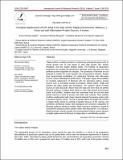Complete replacement of fish meal in the diet of Nile tilapia (Oreochromis niloticus L.) grow-out with alternative protein sources. A review
Publication Date
2014Author
Erick Ochieng Ogello, Jonathan Mbonge Munguti, Yoshitaka Sakakura, Atsushi Hagiwara
Metadata
Show full item recordAbstract/
Tilapia culture is widely practiced in tropical and subtropical regions with an
annual growth rate of 12% thanks to their high growth rate, disease
resistance, and low trophic feeding levels. The increase of aquaculture
production has doubled the demand for fishmeal, which has been the most
preferred protein ingredient for decades. The provisions of fishmeal are not
adequate to sustain the current growth rate of aquaculture industry. Studies
have demonstrated possibilities of substituting fishmeal with alternative
sources without affecting fish performance. This paper argues the possibility
of complete replacement of fishmeal with the alternative dietary protein
sources such as terrestrial animal by-products, oilseed plants, single cell
proteins and plant protein rich derivatives. The nutritive values of these
sources are also discussed. Blood meal and meat and bone meal are perfect
fishmeal replacers in tilapia feeds thanks to their high protein and essential
amino acid profiles. Soybean meal and cottonseed meal are the best plant
protein sources in terms of protein and amino acid contents. Plant proteins
could be supplemented with cheap minerals instead of expensive amino acids
to produce superior results. The use of aquatic plants and single cell proteins
in tilapia feeds should be carefully evaluated because of the varying, and
sometimes conflicting results. Both biological and economic evaluations of
fishmeal replacers should be studied. More long-term evaluations should be
conducted in practical culture systems rather than laboratories. In conclusion,
tilapia producers should consider the unconventional dietary sources because
complete replacement of fishmeal in tilapia diets is scientifically possible.

